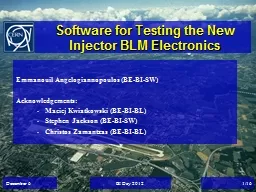

Emmanouil Angelogiannopoulos BEBISW Acknowledgements Maciej Kwiatkowski BEBIBL Stephen Jackson BEBISW Christos Zamantzas BEBIBL December 6 BI Day 2012 1 16 Outline ID: 782337
Download The PPT/PDF document "Software for Testing the New Injector BL..." is the property of its rightful owner. Permission is granted to download and print the materials on this web site for personal, non-commercial use only, and to display it on your personal computer provided you do not modify the materials and that you retain all copyright notices contained in the materials. By downloading content from our website, you accept the terms of this agreement.
Slide1
Software for Testing the New Injector BLM Electronics
Emmanouil Angelogiannopoulos (BE-BI-SW)Acknowledgements:Maciej Kwiatkowski (BE-BI-BL)Stephen Jackson (BE-BI-SW)Christos Zamantzas (BE-BI-BL)
December 6
BI Day 2012
1
/16
Slide2Outline
Motivation for this projectTechnical details with examplesResultsConclusionsDecember 6BI Day 20122/16
Slide3Final System Implementation
December 6BI Day 20123/16Final architecture of the new BLM system:Detectors in tunnelAcquisition crate (BLEDP)
VME crate
Processing electronics (BLEPT)
FESA server on Linux CPU providing data to clients and dealing with settings and interlocks
Slide4Test System Implementation
December 6BI Day 20124/16VME processing electronics not yet available
Replacing
fibre module with Ethernet allows standalone
implementation
Nios
-II software-implemented
CPU allows custom
server.
Expert BI software communicates
directly with the BLEDP
module
Topic of this talk
Slide5Objectives for the Expert Software
Debug and verify the hardware Further develop the analogue circuits and the final firmwareAssist in the development of the FPGA algorithms to merge the acquired dataUser-friendly environment
Real-time data-viewing and parallel logging to files
December 6
BI Day 2012
5
/16
Slide6Software, Firmware and Hardware Development Phases
December 6BI Day 20126/16Analogue and PCB DesignProtocol and SoftwareSpecificationNios II firmware development
Testing & Validation
Expert GUI Client
Slide7Two Types of Data Provided
December 6BI Day 20127/16Acquisition data8 channels per BLEDP module2 measurement methods:Low current measurement (in pA
)
High
current measurement
(in mA)
Status data
Number of sensors and parameters to be
monitored
Data rate
1s
Slide8Protocol SpecificationDecember 6
BI Day 20128/16The protocol for the client-server architecture:Header to identify data source, measurement method, continuity problems.Header + payload = 32 bit data frame.350 data frames packed into data bundle. Size is selected to avoid IP fragmentation.Status data
buffers.
4 byte
commands.
Both TCP and UDP can be
used.
Slide9Development PhasesDecember 6
BI Day 20129/16Processed data from one channelProcessed data from all eight channelsRaw ADC data from one channelTCP protocol
16 Mbit/s
128 Mbit/s
UDP protocol
320 Mbit/s
UDP protocol
Type of acquisition data supported by the module:
2. Status Data with 1 Hz frequency interleaving with all the above types.
Slide10Online PanelDecember 6
BI Day 201210/16The user should set different parameters before starting communication with the
module. Most of
them are
saved from previous sessions on the same
computer or have default values.
Acquisition parameters like Data type mode, channel number and acquisition time should always be set manually.
After these steps the acquisition can start and real-time data from the module are plotted in the graph.
It is possible to stop the acquisition at any time.
User can also define Units and Scale in the Y Axis.
The user can also select whether or not to save incoming data to the hard drive. This process is executed in parallel with the real time plotting. It is important for further offline analysis, that will be explained in the next slides.
We can see a video example with real time plotting.
Slide11Online Panel VideoDecember 6
BI Day 201211/16
Slide12Offline PanelDecember 6
BI Day 201212Open a file search window to select an acquisition folder from a previous online session.
Mac address of a module.
Different acquisition sessions for this module to select.
Upper graph is the picker. It is plotted from statistics files inside the selected session folder and contains minimum, maximum and average values of the data for each second. The user has to pick a second with the mouse.
The picked second is marked in the upper graph and the data are mined from the corresponding file and then plotted with the desired accuracy in the lower graph.
11/16
A zooming video example follows.
Slide13Offline Panel VideoDecember 6
BI Day 201213/16
Slide14Status Panel
December 6BI Day 201214/16
Plot selected status packets in these three graphs with 1 Hz update rate: current consumption, high voltage monitoring, temperature and humidity.
In the first graph are plotted acquisition data from the selected channel with 1 Hz update rate also. The plots of the four graphs are aligned.
E.g. Influence of a power supply problem on the measurements can be seen here.
LEDs show status of the power supplies and the calibration relays.
Print in textboxes: values which are plotted and additional like digital potentiometers settings and event counters.
Slide15Conclusion
Direct Ethernet communication allowed a standalone implementation Collaboration between BL (hardware, firmware) and SW (Expert GUI) sectionsSoftware and the firmware development was split:Processed Data from one channelProcessed data from all 8 channelsRaw Data from one channelExpert GUI allowed developing of both firmware and hardwareOffline data storage allowed detailed analysis of the RT algorithm implemented in the FPGADecember 6
BI Day 2012
15
/16
Slide16December 6
BI Day 201216/16 Thank you for your attention!People involved in the Project: Christos Zamantzas (BE-BI-BL) Stephen Jackson (BE-BI-SW) Analog design:
William Viganό
(BE-BI-BL)
Firmware
design: Marcel Alsdorf, Maciej Kwiatkowski (BE-BI-BL)
Software
design:
Emmanouil
Angelogiannopoulos (BE-BI-SW)